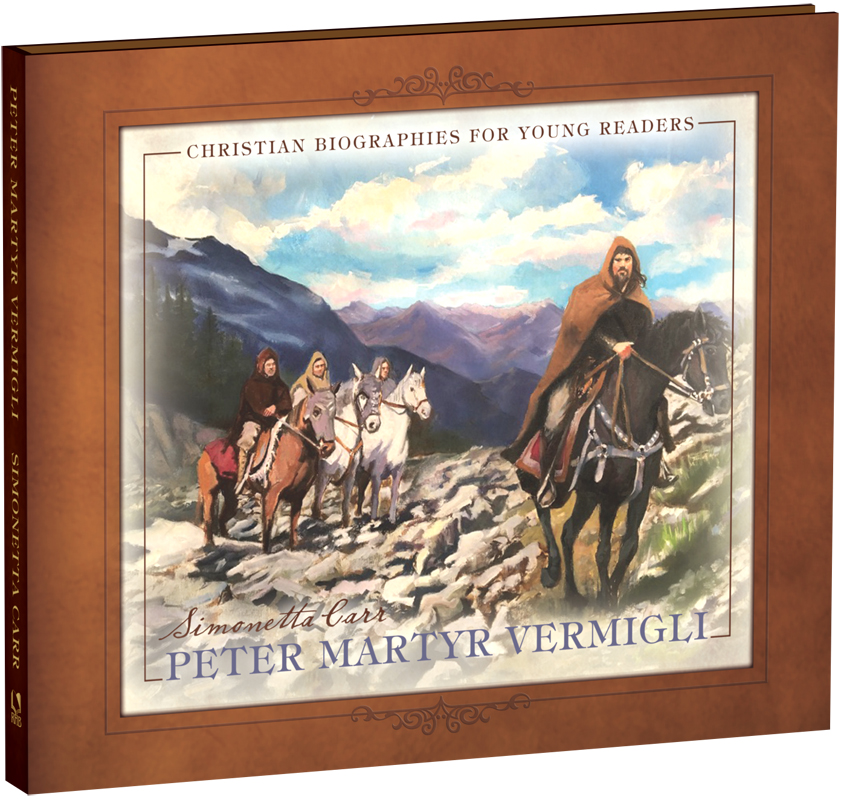This is a guest post from Simonetta Carr, author of Peter Martyr Vermigli, the latest in a series of illustrated children’s book on various important figures in church history. You can see the rest of the range here.
 Peter who? Today, the name Peter Martyr Vermigli, highly esteemed during the Reformation, rings very few bells. Why then a book on his life for children? There are several reasons why I chose to write about him on this five-hundredth anniversary of the Reformation. And no, it’s not because, like me, he was born in Italy but spent most of his life abroad.
Peter who? Today, the name Peter Martyr Vermigli, highly esteemed during the Reformation, rings very few bells. Why then a book on his life for children? There are several reasons why I chose to write about him on this five-hundredth anniversary of the Reformation. And no, it’s not because, like me, he was born in Italy but spent most of his life abroad.
Respected Reformer
1. He was one of the most respected Reformers of the time, probably equal to John Calvin and Theodore Beza. Calvin attached such a high value to Vermigli’s works and was so eager to read them that on May 22, 1558, he wrote impatiently, “Is there no one there [in Zurich] who can forcibly extricate from your hands the things you are writing?”
Continental Influence
2. Vermigli is the ideal Reformer to introduce to children on the anniversary of the Reformation, because he lived in several countries of Europe, leaving an impact on the continent as a whole. It has often been said that the pivotal religious movements of the sixteenth century are best described as Reformations rather than the Reformation. The rediscovery of the biblical sources and particularly of the gospel and the desire to return to the purity of biblical teachings were common denominators, but each country had, in some ways, a different and distinct Reformation. Vermigli participated in many of them.
Born in Florence, Italy, in 1499, he entered the Order of the Canons Regular of St. Augustine and was ordained a priest. Having achieved an extensive education in philosophy and theology, he participated in the highly heterogenous Italian Reformation, which was driven mostly by a desire to reform the morality of the church but also drew many theological themes from Reformers like Luther, Bucer, and Calvin.
Forced to leave Italy, Vermigli lived, wrote, and taught in Switzerland, Germany, and England, leaving an enormous impact on each of these countries. He also influenced many other Reformers, including the Polish John Lasko, who became one of the most distinguished Protestant Reformers in his country. Around the end of his life, Vermigli also had some influence on Catherine de’ Medici, the de facto ruler of France, by participating at the Colloquy of Poissy and conferring with her privately in their common mother tongue.
By reading Peter Martyr Vermigli, children will learn the different challenges the Protestant Reformation faced in various European countries and will see how God allowed His truth to thrive in spite of seemingly insurmountable obstacles.
Creeds and Confessions
3. Vermigli lived at a time when the Reformation was maturing and consolidating into creeds and confessions. In England, his lectures and personal advice strongly influenced the Church of England’s Book of Common Prayer and Thirty-Nine Articles of Religion. He also influenced a generation of scholars who went on to work on other important documents of the Protestant church, such as the Heidelberg Catechism and the Canons of Dordt.
Inner Struggle
4. Vermigli’s life helps us see the inner struggle of a Roman Catholic priest faced with the choice of accepting what he had come to believe as undeniable biblical truths or conforming to widespread interpretations and impositions. Opting to obey the voice of his conscience cost him his position, his church, and his country. What motivated him to make such a drastic decision?
One of my favorite quotes about our cultural distance from the Reformation comes from Eric Ives’s Lady Jane Grey—A Tudor Mystery: “In the West, growing secularization ensures that relatively few people even understand the issues which meant so much to [Jane].” Hopefully, Peter Martyr Vermigli will help children become more acquainted with some of these issues and equip them to grasp the motivations behind the Reformers’ choices.
For example, one of the main issues at that time concerned the Lord’s Supper and the Roman Catholic Mass, something many people, in our age of ecumenical cooperation, brush off as unimportant and even divisive. During the Reformation, the Mass was considered an idolatrous and blasphemous act, one that Vermigli and many others could not in good conscience perform or even attend, and the book Peter Martyr Vermigli explains why.
Another important issue for Vermigli was the spiritual poverty of most sermons and the lack of religious education. Often, the first stemmed from the latter, as uneducated preachers could not feed God’s spiritual sheep. Teaching God’s Word was the passion of Vermigli’s life from his early youth to the day he died, setting an example for generations to come.
On this five-hundredth anniversary of the Protestant Reformation, it is my hope that Peter Martyr Vermigli will bring children closer to some of the protagonists of that crucial historical time and give them a better understanding of the convictions, motivations, and passions that should still move all those who today choose to call themselves Protestant and Reformed.
Pingback: The Most Important Reformer You’ve Never Heard Of - The Aquila Report